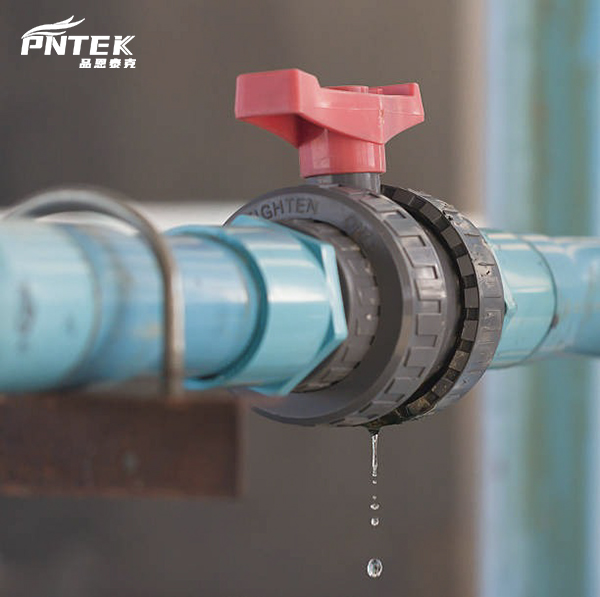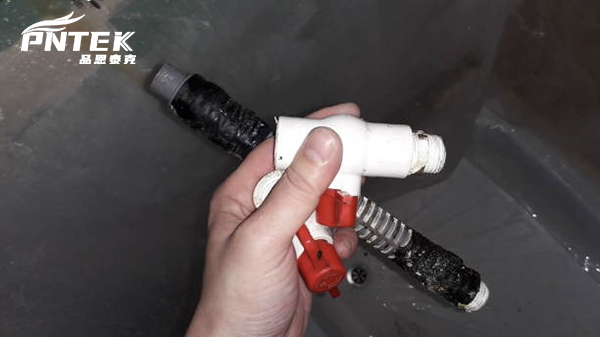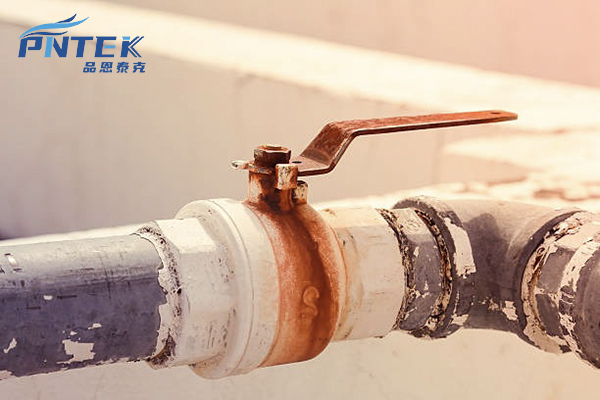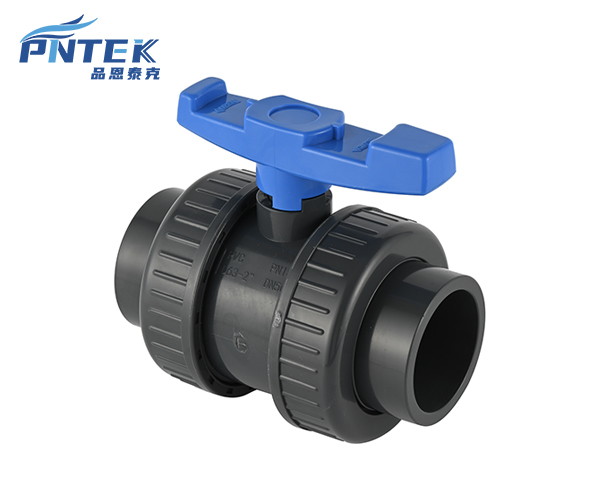You installed a new valve, expecting a perfect seal. A slow, silent drip could be causing water damage right now, completely without your knowledge and ruining your hard work.
A high-quality PVC ball valve should not leak. Leaks almost always happen due to improper installation, physical damage, or extreme age, not because of a manufacturing defect in a well-made valve.

This is a critical point of trust between a manufacturer and a professional. When I discuss our product quality with partners like Budi in Indonesia, this is a topic we cover in detail. His customers, the contractors and builders, rely on the components they install to be flawless. A single leak can damage their reputation. So, it is vital to understand that the valve itself is designed to be leak-proof. The real focus needs to be on the common causes of leaks that happen in the field, which are almost always preventable.
Can PVC ball valves leak?
You have glued a PVC valve and the job is complete. But a tiny flaw in the joint can cause a leak later, forcing a frustrating and costly do-over.
Yes, they can leak. The most common leak points are not the valve’s internal seals but the external connections—either poorly glued solvent joints or improperly sealed threaded connections, not the valve body itself.

Even the best valve in the world will leak if it is not installed correctly. Understanding where leaks happen is the first step to preventing them. In my experience, there are three primary places a leak can develop.
1. Leaks at the Connections (Most Common)
This is where over 90% of leaks occur.
- Solvent-Welded Joints: A leak here means the chemical weld was not perfect. This can happen if not enough cement was used, the pipe wasn”t fully inserted into the valve socket, or the crucial quarter-turn twist wasn’t performed to spread the cement evenly.
- Threaded Connections: Leaks at threaded joints usually result from not using enough PTFE thread seal tape or using it incorrectly. Over-tightening is another major cause; it can create a micro-crack in the female fitting, leading to a slow drip.
2. Leaks from the Handle Stem
This is less common, especially on new valves. Inside the valve, the stem that connects to the handle is sealed by one or more EPDM O-rings. If a leak appears right under the handle, it means this seal is compromised. On a true union valve, you can sometimes tighten a packing nut to compress this seal and stop the leak. On a compact valve, this usually requires replacement.
3. Leaks Through the Valve (Internal)
This is the rarest type of leak on a quality valve. This means the valve is dripping when it is in the closed position. This usually happens because debris like a small rock or sand is caught inside, preventing the ball from sealing fully against the PTFE seat.
How reliable are PVC ball valves?
You need a valve you can install and trust for years. Choosing a cheap, unproven valve can lead to callbacks, hurting your reputation and profit on the job.
High-quality PVC ball valves are extremely reliable due to their simple design with few moving parts. Their reliability depends entirely on the quality of materials and precision manufacturing used to make them.

The simple brilliance of a ball valve is what makes it so trustworthy. The design is mechanically sound: a ball with a hole rotates 90 degrees to an open or closed position. There are very few things that can go wrong. However, not all PVC ball valves are created equal. The difference between a reliable valve and an unreliable one comes down to the quality of the raw materials and the production process. This is something we at Pntek take very seriously. A cheap valve may look the same on the outside, but it is what is inside that counts.
| Component | High-Quality Pntek Valve | Low-Quality Generic Valve | Impact on Reliability |
|---|---|---|---|
| Valve Body | 100% Virgin PVC | Recycled PVC with fillers (calcium) | Virgin PVC is strong and impact-resistant. Recycled material can be brittle and crack under pressure or during installation. |
| Ball | Precision-machined, smooth | Rough surface, inconsistent size | A smooth ball creates a perfect seal and turns easily. A rough ball will wear out the seats and cause leaks. |
| Seats | 100% Virgin PTFE | Cheaper plastics | PTFE (Teflon) provides a low-friction, durable, and chemically resistant seal. Cheaper materials can stick or degrade quickly. |
| O-Rings | EPDM or FKM (Viton) | Basic rubber (NBR) | EPDM offers excellent resistance to heat and chemicals in water systems. Basic rubber can swell or break down over time. |
A reliable valve is an investment in peace of mind.
How long will a PVC ball valve last?
You need to know the lifespan of the components you install. But valves lack a clear expiry date, making long-term planning difficult and creating uncertainty for clients about future problems.
A well-made PVC ball valve, used in the right conditions, can easily last 10 to 25 years or more. Lifespan is most affected by UV radiation, temperature, chemical exposure, and how often it is operated.

There is no fixed expiration date for a PVC valve because its lifespan depends heavily on its environment and how it’s used. A valve installed indoors on a cold water line that is only used a few times a year might last for decades. A valve installed outdoors on a hot water line that is operated daily will have a much shorter life. Understanding the factors that shorten a valve’s life is key to maximizing it.
- UV Exposure: This is the biggest enemy of PVC. Direct sunlight makes PVC brittle over time. Any valve installed outdoors should be protected from the sun, either by wrapping it or painting it with a water-based latex paint.
- High Temperature: PVC gets softer as it gets hotter, which reduces its pressure rating. A valve constantly exposed to hot water (near its maximum limit of 140°F / 60°C) is under more stress and will age faster.
- Chemicals: While PVC is resistant to many chemicals, aggressive substances can attack the plastic or the EPDM/FKM seals. Always check a chemical compatibility chart if the valve will be used for anything other than water.
- Frequency of Use: A valve is a mechanical device. The more it is turned, the more the seats and seals will wear. For high-cycle applications, it’s important to choose a valve designed for that purpose.
How to stop a ball valve from leaking?
You have spotted a dreaded drip from a valve connection. Your first thought is a difficult repair, cutting out pipe and wasting hours of your time and effort.
For leaks at the handle, try tightening the union nuts or packing nut. For threaded leaks, you must re-seal the threads. For leaks at a glued joint, the valve must be cut out and replaced.

Fixing a leak depends entirely on where the water is coming from. The first step is to turn off the water supply and release any pressure in the line.
Fixing a Leak from the Handle Stem
This leak appears as a drip right where the handle enters the valve body. On our Pntek true union valves, this is often repairable. You can unscrew the large union nuts on either side of the valve body. This allows you to lift the valve’s core out of the pipeline. On this core, there is a large nut around the stem. Gently tightening this nut (called a carrier or packing nut) can compress the O-rings and stop the leak. On compact, one-piece valves, this is not possible and the valve must be replaced.
Fixing a Leak from a Threaded Connection
This is a fixable but annoying leak. You must completely unthread the valve from the fitting. Thoroughly clean all the old thread sealant tape or paste from both the male and female threads. Then, re-apply fresh, high-quality PTFE tape (3-4 wraps in the direction of the threads). Reassemble the joint, tightening it firmly but being careful not to over-tighten and crack the fitting.
Fixing a Leak from a Solvent Weld (Glued) Joint
This is the one leak you cannot fix. There is no product or method that can reliably patch a leaking solvent-welded joint. The only professional and permanent solution is to cut the valve out of the pipeline and install a new one. This is why it is so important to get the gluing process right the first time.
Conclusion
A quality PVC valve should not leak. Leaks are almost always from installation errors, not the valve itself. Knowing the cause is the key to a quick, permanent fix.
Post time: Sep-11-2025




